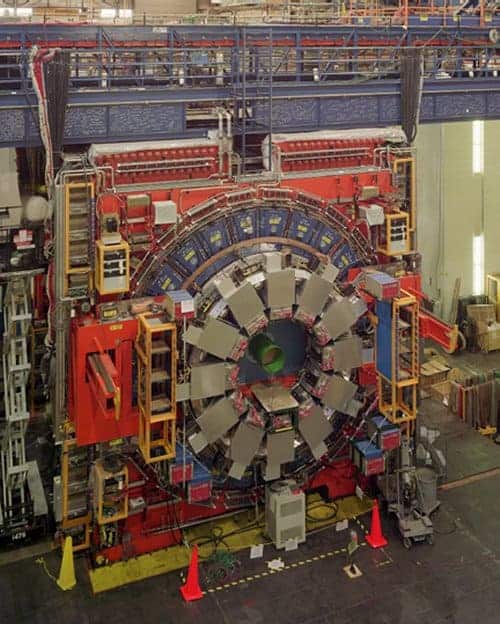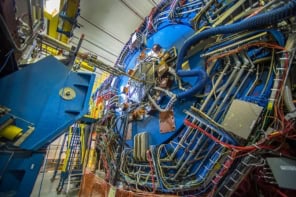
Physicists at the Tevatron collider at Fermilab in the US, which is enjoying extended status as the world’s most powerful particle collider while CERN’s Large Hadron Collider (LHC) awaits repair, have reported signals in their data that hint at the existence of new fundamental particles. Last week members of the CDF experiment, one of the Tevatron’s two huge particle detectors, posted a preprint detailing a large sample of proton–antiproton collisions that cannot be accounted for either by quirks of the CDF detector or by known processes in the standard model of particle physics (arXiv:0810.5357 , submitted to PRD).
If the result does turn out to be due to some unexpected new process, it would be the most significant discovery in particle physics for decades. However, almost a third of CDF’s 600 or so collaborators (including some entire university groups) decided not to put their names on the paper, many believing that publication was premature because more checks need to be done.
“This is a very interesting and statistically significant effect,” says CDF member Mark Lancaster of University College London, who was one of those who removed his name. “The spirit of this paper is to get the result out there so that it can be checked by others, but the analysis is a work in progress.”
No claims
Claiming a discovery of physics beyond the 35-year-old standard model is not something physicists take lightly, which is why the 70 page long CDF paper does not make such a claim. Rather, it describes a subset of proton–antiproton collisions in which newly produced B mesons and anti-mesons fly a certain distance before decaying into pairs of muons, which are tracked by CDF’s inner detector. From some 300,000 events in which at least one muon originated beyond the Tevatron’s 1.5 cm radius beam pipe, CDF finds some 70,000 which contain more muons than expected.
“We present the bare facts,” analysis leader Paulo Giromini told physicsworld.com. “We poked fun at ourselves by publishing the paper on Halloween and calling the events ghosts, but we have performed all the sanity checks we could possibly think of. While each single feature of the signal can be explained by stretching the systematic uncertainty of our detector response, we cannot think of a way to construct a correlation between the different features.”
Unlike some scents of discovery in particle physics, such as claimed sightings of the Higgs boson at CERN’s previous collider LEP in 2000, the CDF data are not limited by statistical uncertainties due to a small event sample. Instead, researchers have to be sure the readings from the CDF detector can be fully trusted in the region close to the Tevatron’s beam pipe and must convince themselves (and one another) that the standard model “background” processes — many of which rely on a detailed understanding of quantum chromodynamics — do not provide a more mundane explanation.
Peter Renton of Oxford University says that independent studies within CDF are investigating possible standard-model backgrounds. “The Oxford CDF group [which did not appear on the paper] believes that these studies should be completed before drawing any conclusion on the nature of the events,” he said.
Your model or mine?
CDF’s vetting procedure, during which publications are assigned “godparents” and must be “blessed” before being released to the outside world, forced some of the original wording about possible interpretations of the excess events to be removed from the paper since July when it was unveiled to the collaboration. But shortly after it was posted last week, Giromini and six others released a separate preprint late on Friday in which they suggest the anomalous events can be explained by the existence of three new particles with masses of about 15, 7.3 and 3.6 GeV (arXiv:0810.5730v1).
Although the team does not know what mechanism could produce the heavier particle to begin with, the idea is that this particle decays into the lighter ones which subsequently decay into pairs of tau particles (heavy copies of muons) and, finally, into muons. Because the lightest state is presumed to decay into a pair of taus with a lifetime of about 20 ps, this can account for the mysterious muons originating beyond the beam pipe.
Other interpretations are sure to follow. In fact, last month Nina Arkani Hamed of the Institute for Advanced Study at Princeton and Neal Weiner of New York University predicted a CDF-like signal from a “superunified theory of dark matter” that was constructed in part to explain possible sightings of dark matter by the PAMELA experiment, which recently detected an excess of positrons in cosmic ray data (arXiv:0810.0714v2).
“Simple explanations of the PAMELA excess seem to require new particles at the GeV scale decaying into leptons [which include taus and muons],” said Weiner. “That CDF may be seeing a similar signature is certainly exciting, but the signature we discussed appears to be at far too low a rate to explain what they see and a lot of work remains before we can determine if the signatures are consistent.”
Cross check
The CDF analysis has parallels with one led by Giromini in 2003, which concerned signs of new physics via an excess in the number of particle “jets” in earlier CDF data. It is exactly this kind of painstaking comparison between data and simulations that LHC physicists will be undertaking in the next few years in their search for new particles, only with detectors considerably more complicated (and presently less well understood) than those at the Tevatron.
All eyes are now on CDF’s sister experiment D0 to see if it can spot the same muon excess and thus harden the case for new physics. “We just learned of this result on Friday, but the D0 detector has an excellent muon system so we should be able to do a meaningful crosscheck of this excess,” explained D0 spokespersons Darien Wood and Dmitri Denisov. “We are not putting everything else on hold, but we will try to investigate it seriously.”
Meanwhile, Giromini is keen that the CDF muon excess does not get overhyped. “In my personal opinion the CDF analysis was not particularly controversial, but definitely the outcome scared the living daylights out of number of people,” he says.
Although highly unusual for so many members of a particle physics collaboration to remove their names from a paper, CDF co-spokesperson Jacobo Konigsberg of Florida University says that overall it was a nice discourse. “It’s expected that some people will feel uncomfortable signing such a technical preprint presenting results that cannot fully be explained, and which may turn out to have a mundane origin,” he said.



